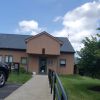What Is Heart Disease in Children?
Heart disease in children refers to a range of conditions affecting the heart's structure and function. These conditions can either be present at birth (congenital) or develop later in life (acquired). While heart disease in children is relatively rare, it is still a leading cause of death among children worldwide. Understanding the various types of heart disease and their causes is crucial for early diagnosis and intervention.
Congenital heart disease (CHD) is the most common form, where a child is born with a defect in the heart. These defects can range from mild conditions that require little treatment to severe cases needing surgery or a transplant. Acquired heart disease can result from infections, genetic conditions, or lifestyle factors that influence the health of the heart.
Common Causes of Heart Disease in Children
Several factors contribute to heart disease in children. Some of these factors are genetic, while others are environmental. Here are the most common causes:
- Congenital Defects: Many children are born with heart defects that can affect the heart’s chambers, valves, or blood vessels. These can include conditions like holes in the heart (septal defects), narrowing of arteries (stenosis), and abnormal heart rhythms.
- Infections: Certain viral infections, such as myocarditis (inflammation of the heart muscle), can lead to heart disease in children. Bacterial infections like rheumatic fever can also cause heart damage if left untreated.
- Genetic Disorders: Conditions like Down syndrome or Marfan syndrome can increase the risk of heart disease in children. These genetic disorders can affect the development and function of the heart.
- Lifestyle Factors: Although less common in younger children, poor diet, lack of exercise, and obesity can contribute to heart disease in older children and teenagers.
Identifying Symptoms of Heart Disease in Children
Recognizing the symptoms of heart disease in children is crucial for prompt diagnosis and treatment. While some children may show no symptoms, others may experience a variety of signs that indicate a potential heart problem. Common symptoms include:
- Fatigue: Children with heart disease may tire easily and struggle to keep up with their peers in physical activities.
- Breathing Problems: Difficulty breathing, especially after exertion, or shortness of breath during everyday activities, could be a sign of a heart condition.
- Chest Pain: Though rare, chest pain in children may occur and should never be ignored, especially if it happens during exercise or physical exertion.
- Swelling: Swelling in the legs, abdomen, or face can be a sign of heart failure or fluid retention due to poor heart function.
- Blue Tinge to the Skin: If a child’s skin turns blue or pale, it could be a sign of low oxygen levels in the blood, which may result from a heart condition.
Treatment Options for Heart Disease in Children
The treatment for heart disease in children depends on the type and severity of the condition. Some children may require medications, while others may need surgery or even a heart transplant. Below are the most common treatment options:
- Medications: Certain heart conditions can be managed with medications that help control symptoms, such as high blood pressure, arrhythmias (irregular heartbeats), or fluid buildup in the body.
- Surgery: For congenital heart defects, surgery is often required to correct structural problems in the heart. This can involve repairing or replacing heart valves, closing holes in the heart, or bypassing blocked arteries.
- Heart Transplant: In severe cases of heart failure, a heart transplant may be necessary. This is typically reserved for children with end-stage heart disease where other treatments have failed.
- Lifestyle Changes: For acquired heart disease, managing lifestyle factors such as diet, exercise, and weight control can play a significant role in treatment.
Real-Life Case Study: Heart Disease in Children
One example that illustrates the importance of early detection and treatment involves a young girl named Emma. At just 3 years old, Emma was diagnosed with a congenital heart defect known as a ventricular septal defect (VSD), a hole in the wall between the heart’s ventricles. While many children with VSD may live without symptoms, Emma experienced fatigue and trouble breathing during play.
After a thorough examination, Emma underwent surgery to close the hole in her heart. Today, she is thriving and enjoying her childhood, thanks to early detection and timely intervention. Emma’s story is a powerful reminder that heart disease in children can be treated effectively with the right care and medical attention.




















